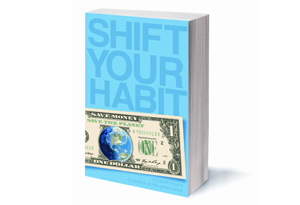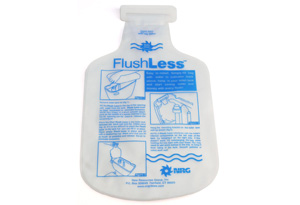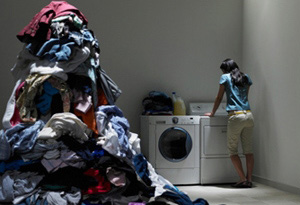Shift Your Habit to a Fresh Start This Spring

What better time than the first days of spring to start Elizabeth Rogers' Shift Your Habit, a new way of thinking that leads to both saving money and living consciously? It's about transformation. It's about your life and making it better. It's about changes that can have an impact on you, your family, your friends and the world you live in.
Spring marks a season of new beginnings. Leaves reappear on the trees, the sun stays out longer, the weather gets warmer and there is renewed motivation to make some positive changes before summer arrives. Whether you're planning to spend a few days or weeks doing spring-cleaning or are looking for a way to get a little extra sunlight and fresh air, Shift Your Habit can help you make a few small changes that could help you save big and live better.Sun In—Save $90
If you have ample daylight coming in through the windows, open the drapes, turn off the inside lights and let the sun illuminate your home. You could save up to $90 or more per year on your energy bill by turning off just five 60-watt bulbs for eight hours each day.
Studies have shown that working in natural light improves comfort level and mood, making people more productive. Substantial research has also found a relation between artificial lighting—or lack of natural light—and a range of problems including depression, increased stress, headaches, afternoon tiredness, sleep disturbances and concentration and learning difficulties.

Throw in the Towels—Save $105
Whether you're dusting furniture, cleaning mirrors or wiping up a spill, use a washable cleaning cloth instead of using rolls and rolls of paper towels. You could save up to $150 per year if you currently use two large rolls per week. You'll also conserve up to 30 pounds or more of tissue-grade paper, which is made from trees, manufactured using hundreds of gallons of water and treated with harsh chemicals and bleach. You'll also keep this paper waste from entering the landfill.
Whether you're dusting furniture, cleaning mirrors or wiping up a spill, use a washable cleaning cloth instead of using rolls and rolls of paper towels. You could save up to $150 per year if you currently use two large rolls per week. You'll also conserve up to 30 pounds or more of tissue-grade paper, which is made from trees, manufactured using hundreds of gallons of water and treated with harsh chemicals and bleach. You'll also keep this paper waste from entering the landfill.

Get Tanked—Save $35
If you have an older toilet that uses more than 1.6 gallons per flush, try using this MacGyver method to minimize water use. Buy a tank displacement bag or fill a half-gallon glass or plastic bottle with water (don't use a brick) and then place it in the toilet tank away from the moving parts. The half-gallon of water you displace in the tank will be saved every time you flush, which will save you nearly 8,700 gallons of water and up to $35 on water and sewage costs per year for a family of four—even if no one flushes less than normal.
If you have an older toilet that uses more than 1.6 gallons per flush, try using this MacGyver method to minimize water use. Buy a tank displacement bag or fill a half-gallon glass or plastic bottle with water (don't use a brick) and then place it in the toilet tank away from the moving parts. The half-gallon of water you displace in the tank will be saved every time you flush, which will save you nearly 8,700 gallons of water and up to $35 on water and sewage costs per year for a family of four—even if no one flushes less than normal.
Play Kitchen Chemist—Save $200
Replace your standard household cleaning products with home remedies—just like the ones your grandma used. You could save up to $200 per year on commercial cleaning products and avoid exposing your family—and our groundwater—to tons of toxic substances.
Use these recipes:
All-Purpose Cleaner
8 cups of water
1/2 cup white vinegar
1/4 baking soda
Mix in a spray bottle. Good for hard water stains. Can be stored for later use.
Disinfectant All-Purpose Cleaner
2 cups water
3 drops Castile soap
30 drops lavender essential oil
Mix in spray bottle. Use on any surface (countertop, toilet, tile, kid's room).
Glass Cleaner
1 1/2 to 2 cups water
1/2 cup white vinegar
1/4 cup rubbing alcohol (70 percent)
1 to 2 drops essential oil
Mix in spray bottle. Use to clean all glass surfaces or mirrors. Use newspaper instead of paper towels if possible.
Oven/Stove Cleaner
1 Tbsp. water
2 Tbsp. baking soda
Mix ingredients in bowl or jar. Apply paste to spill spots. Let sit for two hours. Wipe up with sponge or scrub with old toothbrush.
Toilet Cleaner
1 cup white vinegar
1/4 cup baking soda
Mix ingredients in bowl or jar. Pour into toilet. After three minutes, scrub with brush and flush.
Bathroom Cleaner
1/2 cup water
1/4 cup hydrogen peroxide
Mix in spray bottle. Spray on areas with mold and leave on for at least an hour before rinsing.
Soap Scum
1/4 cup water
1/2 cup baking soda
Mix ingredients to make paste. Use to scour away soap scum with clean sponge, cloth or bristle brush.
Drain Cleaner
8 cups water
1 cup white vinegar
1 cup baking soda
Pour baking soda down the drain followed by the vinegar. Let sit for five minutes. Flush down with near-boiling water.
Carpet Stain Remover
1/4 cup white vinegar
1/4 borax
1/4 cup salt
Mix in bowl or jar. Rub paste into carpet and let dry. Then vacuum.
Carpet Deodorizers
1 cup white vinegar
1/4 cup dried herbs (lavender, basil or rosemary)
Mix ingredients in flour sifter and sprinkle around room. Vacuum after 30 minutes.
Wood Furniture Polish
2 tbsp. borax
1/4 cup lemon juice
Mix and apply to clean cotton cloth. Use wide strokes to polish wood surface.
Fabric Softener
1/2 cup white vinegar
Add to rinse cycle in place of liquid fabric softener.
Replace your standard household cleaning products with home remedies—just like the ones your grandma used. You could save up to $200 per year on commercial cleaning products and avoid exposing your family—and our groundwater—to tons of toxic substances.
Use these recipes:
All-Purpose Cleaner
8 cups of water
1/2 cup white vinegar
1/4 baking soda
Mix in a spray bottle. Good for hard water stains. Can be stored for later use.
Disinfectant All-Purpose Cleaner
2 cups water
3 drops Castile soap
30 drops lavender essential oil
Mix in spray bottle. Use on any surface (countertop, toilet, tile, kid's room).
Glass Cleaner
1 1/2 to 2 cups water
1/2 cup white vinegar
1/4 cup rubbing alcohol (70 percent)
1 to 2 drops essential oil
Mix in spray bottle. Use to clean all glass surfaces or mirrors. Use newspaper instead of paper towels if possible.
Oven/Stove Cleaner
1 Tbsp. water
2 Tbsp. baking soda
Mix ingredients in bowl or jar. Apply paste to spill spots. Let sit for two hours. Wipe up with sponge or scrub with old toothbrush.
Toilet Cleaner
1 cup white vinegar
1/4 cup baking soda
Mix ingredients in bowl or jar. Pour into toilet. After three minutes, scrub with brush and flush.
Bathroom Cleaner
1/2 cup water
1/4 cup hydrogen peroxide
Mix in spray bottle. Spray on areas with mold and leave on for at least an hour before rinsing.
Soap Scum
1/4 cup water
1/2 cup baking soda
Mix ingredients to make paste. Use to scour away soap scum with clean sponge, cloth or bristle brush.
Drain Cleaner
8 cups water
1 cup white vinegar
1 cup baking soda
Pour baking soda down the drain followed by the vinegar. Let sit for five minutes. Flush down with near-boiling water.
Carpet Stain Remover
1/4 cup white vinegar
1/4 borax
1/4 cup salt
Mix in bowl or jar. Rub paste into carpet and let dry. Then vacuum.
Carpet Deodorizers
1 cup white vinegar
1/4 cup dried herbs (lavender, basil or rosemary)
Mix ingredients in flour sifter and sprinkle around room. Vacuum after 30 minutes.
Wood Furniture Polish
2 tbsp. borax
1/4 cup lemon juice
Mix and apply to clean cotton cloth. Use wide strokes to polish wood surface.
Fabric Softener
1/2 cup white vinegar
Add to rinse cycle in place of liquid fabric softener.

Run Cold, Full Time—Save $150
Do laundry only when you can fill the washer to capacity—and always try to wash in cold water. You'll save up to $150 per year on water and energy costs, conserve 1,700 gallons of water and save nearly 1,500 kilowatt-hours of energy.
Do laundry only when you can fill the washer to capacity—and always try to wash in cold water. You'll save up to $150 per year on water and energy costs, conserve 1,700 gallons of water and save nearly 1,500 kilowatt-hours of energy.

Sheets to the Wind—Save $40
Eliminate the use of conventional store-bought dryer sheets and save up to $40 per year. You'll not only conserve the resources used to make the dryer sheets, but you'll keep yourself and your family from being exposed to the chemicals they contain, some of which are known carcinogens—did you know dryer sheets can be used to repel ants?
Make these do-it-yourself dryer sheets:
Place a couple of drops of your favorite essential oil on a piece of wet cloth and put it in the dryer with your clothes, or fill a small, sealable canvas bag with dried herbs or natural potpourri—lavender smells great—and toss in with wet laundry.
Eliminate the use of conventional store-bought dryer sheets and save up to $40 per year. You'll not only conserve the resources used to make the dryer sheets, but you'll keep yourself and your family from being exposed to the chemicals they contain, some of which are known carcinogens—did you know dryer sheets can be used to repel ants?
Make these do-it-yourself dryer sheets:
Place a couple of drops of your favorite essential oil on a piece of wet cloth and put it in the dryer with your clothes, or fill a small, sealable canvas bag with dried herbs or natural potpourri—lavender smells great—and toss in with wet laundry.

Leftover Makeover—Save $520
Make new meals out of your leftovers and save up to $520 per year or more if repurposing leftovers can save you $10 per week on food costs. You'll also reduce food waste. Being decomposable doesn't mean it will decompose in a landfill.
Before you pitch old food, see if you can bring it back to life.
Stale cereal, crackers, chips or nuts
Bake them in a 300-degree oven for three to five minutes. Place in an airtight container and use within a couple of days.
Overripe bananas
Mix them into banana bread or cookie batter, cookies, cooked oatmeal, pudding or smoothies. In the future, when you have a banana surplus, peel and freeze them before they go brown. You can even impale them on Popsicle sticks and pass them off to your kids as dessert—a chocolate-dipped banana is a real treat.
Wilted lettuce or leafy greens
Soak them in cold water for 30 minutes to revive freshness.
Bruised fruit
Cut off the bruised area and chop the rest into fruit or green salad.
Slightly sour—not moldy—milk
Use it to make scones, cornbread or another baked recipe that calls for milk. You can also use it to moisten pancake batter.
Dried-out fruit
Place it in a Pyrex bowl or jar and cover in boiling water.
Limp celery
Add it to a stir fry, soup or meat dish.
Crystallized brown or white sugar
Microwave it for 30 seconds to soften.
Half-used jars of pasta sauce
Freeze in ice cube trays and use in future culinary masterpieces.
Make new meals out of your leftovers and save up to $520 per year or more if repurposing leftovers can save you $10 per week on food costs. You'll also reduce food waste. Being decomposable doesn't mean it will decompose in a landfill.
Before you pitch old food, see if you can bring it back to life.
Stale cereal, crackers, chips or nuts
Bake them in a 300-degree oven for three to five minutes. Place in an airtight container and use within a couple of days.
Overripe bananas
Mix them into banana bread or cookie batter, cookies, cooked oatmeal, pudding or smoothies. In the future, when you have a banana surplus, peel and freeze them before they go brown. You can even impale them on Popsicle sticks and pass them off to your kids as dessert—a chocolate-dipped banana is a real treat.
Wilted lettuce or leafy greens
Soak them in cold water for 30 minutes to revive freshness.
Bruised fruit
Cut off the bruised area and chop the rest into fruit or green salad.
Slightly sour—not moldy—milk
Use it to make scones, cornbread or another baked recipe that calls for milk. You can also use it to moisten pancake batter.
Dried-out fruit
Place it in a Pyrex bowl or jar and cover in boiling water.
Limp celery
Add it to a stir fry, soup or meat dish.
Crystallized brown or white sugar
Microwave it for 30 seconds to soften.
Half-used jars of pasta sauce
Freeze in ice cube trays and use in future culinary masterpieces.

Toy Swap—Save $200
Arrange to have a toy-trading party with your kids' friends. Have them bring good-condition toys they no longer use and trade them for ones other kids are looking to unload. You could save up to $200 or more per year, which is how much the average family spends per year on toys. Scaling back on the volume of toys you buy and borrowing them instead saves manufacturing energy, decreases plastics production (which uses petroleum and results in pollution), reduces packaging and cuts down on nonrecyclable waste.
Arrange to have a toy-trading party with your kids' friends. Have them bring good-condition toys they no longer use and trade them for ones other kids are looking to unload. You could save up to $200 or more per year, which is how much the average family spends per year on toys. Scaling back on the volume of toys you buy and borrowing them instead saves manufacturing energy, decreases plastics production (which uses petroleum and results in pollution), reduces packaging and cuts down on nonrecyclable waste.

Clothes Swap—Save $100
Clean out your closets—there's money in there! Instead of hitting the mall to replace all the clothes you get rid of during this year's spring cleaning purge, throw a clothing swap party with friends. You'll save up to $100 or more if everyone walks away with a new outfit. You'll also conserve the resources and energy used to produce and transport new clothing. A swap is a great way to catch up with friends you haven't seen in forever. Anything left over can be donated to charity—and it only seems fair that the organizer gets the deduction! As bonus: Many charities will pick up large donations.
Find even more great ways to go green.
What are your best money-saving ways to go green? Share your favorite green habits below.
Elizabeth Rogers is the co-author of The Green Book. Her latest book, Shift Your Habit, is about a new way of thinking that leads to both saving money and living consciously.
Clean out your closets—there's money in there! Instead of hitting the mall to replace all the clothes you get rid of during this year's spring cleaning purge, throw a clothing swap party with friends. You'll save up to $100 or more if everyone walks away with a new outfit. You'll also conserve the resources and energy used to produce and transport new clothing. A swap is a great way to catch up with friends you haven't seen in forever. Anything left over can be donated to charity—and it only seems fair that the organizer gets the deduction! As bonus: Many charities will pick up large donations.
Find even more great ways to go green.
What are your best money-saving ways to go green? Share your favorite green habits below.
Elizabeth Rogers is the co-author of The Green Book. Her latest book, Shift Your Habit, is about a new way of thinking that leads to both saving money and living consciously.



